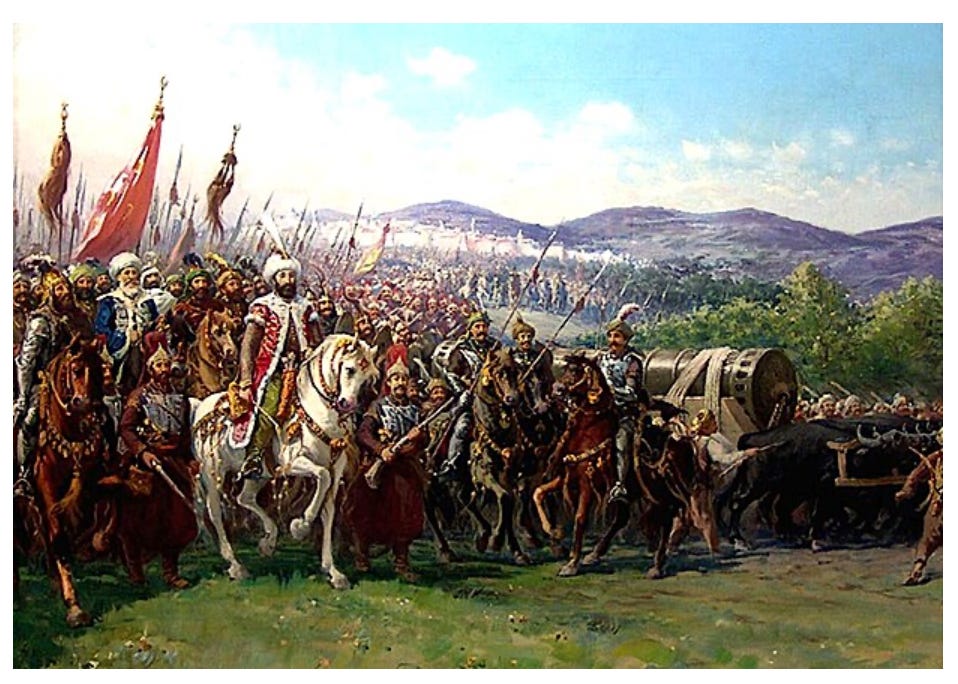“On the 29th of May, 1453, the Turks entered Constantinople and the city was lost to Christendom.”
~ Giornale dell'Assedio di Costantinopoli 1453 di Nicolo Barbaro P.V.Years ago, I was blessed to work at the old Victory Point Games shop in California. One of the pleasant aspects of the work was reviewing game submissions. A few of these designs have stayed with me years afterwards. The Walls of Constantinople is one of them.
The focus of the game is the final assault of the Ottoman Turks, led by their 19-year old leader, Sultan Mehmed, on the Byzantine capital in 1453. The fall of Constantinople was a hinge moment in history, as the decaying Byzantine Empire was finally extinguished. For centuries, the Byzantine Empire had been a Christian bulwark against an expanding Islamic Ottoman Empire. After the fall of Constantinople, for a couple of centuries, the Ottomans pushed deep into the Balkans; twice besieging Vienna. One of my favorite game, Ottoman Sunset, is about the 20th century twilight of the Ottomans.
In classic States of Siege fashion, here the Ottomans advance on Constantinople via three tracks approaching the major gates. The strength of these forces varies between 4, 5, 6. Their approach is random. A fourth Ottoman force attacks via a naval track through the Golden Horn. Instead of the typical cardboard counters, the attacking Ottomans and defenders of the city are represented by cubes. So there is a great tactile look and feel to the game.
The famous walls of the city are themselves represented by cubes. The defenders of Constantinople are weak compared to the Ottomans. Those walls are the key to the defense of the city. Thus, the Ottomans will batter the walls and the Byzantines will repair the damage. This back-and-forth is visible in a very tactile way. You can see and feel the walls as they buckle.
The naval track hinged around what is called the Golden Horn. Entrance to it was protected by a defensive system called the Golden Chain. This outlet gave the city some opportunity for supplies and reinforcements. Eventually, the Ottomans outflank it by portaging many of their smaller ships across a greased log-road. There is an opportunity for some naval skirmishing.
The defenders of the city are a motley crew. They were differentiated between Venetian, Genoan and Byzantine soldiers. There were three different states these soldiers could be in — Exhausted, Committed, Inspired. Rallying the different factions was significant. There was some politics involved. It was a nifty little mechanic. You weren’t just moving troops around, but keeping the team together.
The game had a system where the player’s Actions (called Command Points here) were generated by a matrix based upon morale. As the player’s fortunes wax and wane, their actions fluctuate. There were a lot of different actions a player could choose. Aside from the usual moving and various attacks, the player could repair the walls, inspire troops, some politics.
So, how did it play? Sadly, for a few reasons, the game didn’t hang together. The whole morale matrix simply didn’t work. It was either irrelevant or brutal. The player had ample actions or absolutely too few. Could it be saved with some tuning? I never found out. Soon after, I left VPG.
The larger problem was the setting of the game. Sieges are dull and grinding as each side maneuvers to keep some advantage. But, if the attacker is strong, as the Ottomans were, once they breakthrough, it is over. There is effectively no tactical depth to the Byzantine position. So gameplay is very brittle. Like an egg, once it cracks, it is a mess. In game terms, the lack of maneuver makes it difficult to create a fun game.
That said, I really appreciated the experience of working with cubes. Compared to cardboard counters, the look and feel is wonderful. The flexibility is obvious. A unit gets stronger or weaker; add/remove cube. Mixing of forces is easy and the cubes “tell the story” very well. Seeing five cubes is obviously better than two cubes.
Every publisher of States of Siege type games is seemingly wedded to the idea of using old-school cardboard counters. I am convinced this is an unrecognized cultural assumption by the designers and publishers, who come from a wargaming background. The problem with this presentation is it is off-putting to 98% of your potential customers. As someone who worked in advertising years ago, that’s a bad marketing plan. States of Siege games are not that complex. Cardboard counters create a visual complexity that is off-putting to most gamers. I look forward to the day when a publisher decides to use cubes instead of counters when publishing a States-of-Siege game.











It’s always interesting to hear about projects that never materialized